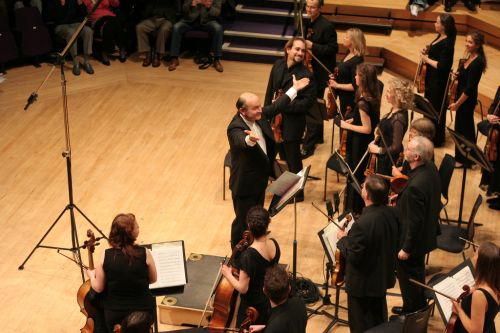 United Kingdom Grieg, Tom Harrold, Mozart, Shchedrin: Christian Ihle Hadland (piano), Manchester Camerata/Gábor Takács-Nagy, Albert Hall, Manchester, 27.4. 2014 (MC)
United Kingdom Grieg, Tom Harrold, Mozart, Shchedrin: Christian Ihle Hadland (piano), Manchester Camerata/Gábor Takács-Nagy, Albert Hall, Manchester, 27.4. 2014 (MC)

Grieg: Holberg Suite, Op. 40
Tom Harrold: The Temptress
Mozart: Piano Concerto No. 12, K.414
Shchedrin: Carmen Suite after Bizet
Works by accordionist Martynas Levickis
A triumph for the Manchester Camerata. This concert was not just about the music it was also about the occasion. It was thrilling to see a packed Albert Hall, the 104 year old Grade II listed Wesleyan Chapel and more recently a nightclub, being used as a concert hall. Both the Camerata players and management team looked as pleased as punch to see such a well received concert. From my position in the balcony the acoustics were excellent albeit some unwanted traffic noise but this is after all a city centre location.
Characterful and melodic the Holberg Suite, one of Grieg’s finest inspirations, made a perfect opener. I’m not sure any conductor exudes as much infectious enjoyment on the podium as Gábor Takács-Nagy who brought a strong response from his talented players.
Tom Harrold the winner of the Camerata Composer’s project was in the audience for this performance of The Temptress scored for five strings and percussionist. Lasting around five minutes the composition is more about mood than melody. It seems that Harrold drew his material from the first sixteen pitches of the aria L’amour est un oiseau rebelle from Bizet’s Carmen but this was imperceptible to my ears.
The Piano Concerto No. 12 is a product of Mozart’s second year in Vienna after leaving the employment of the Salzburg Court, and is an appealing work full of cheerful themes. Engaging and upbeat it’s easy to understand why this work has been described as being Tyrolean in character. For the score Maestro Takács-Nagy chose to play an arrangement that left out the pairs of oboes and horns. Initially I rather missed the colour of the wind instruments but the ear soon became accustomed to the string only accompaniment. An assured soloist with an unflashy style, Christian Ihle Hadland demonstrated his full grasp of this A major score deftly communicating the charm of the cultivated writing with a strong joie de vivre. Pleasingly fresh and spontaneous in the outer movements the Norwegian soloist’s approach to the Andante contained gentle warmth with a sense of intimate music making.
After the interval the Camerata gave a spellbinding performance of Rodion Shchedrin’s colourful Carmen Suite (after Bizet), a ballet score composed for his wife Maya Plisetskaya prima ballerina assoluta at the Bolshoi.A couple of weeks ago I interviewed the Moscow born Shchedrin at his Munich apartment. Talking about the remarkable success of the Carmen Suite both as a ballet and a standalone concert score Shchredin didn’t want to be remembered solely for his Carmen Suite but acknowledged that the work had been very good to him and was extremely happy about that. Link: https://seenandheard-international.com/2014/04/composer-rodion-shchedrin-conversation-michael-cookson-april-2014/?doing_wp_cron=1398717725.1749680042266845703125
Scored for strings and a broad array of percussion instruments what might seem at first a strange concoction of music, prepared by a Russian composer using music from a Spanish themed opera by a French composer, works exceptionally well. From the many distinctive facets of the performance notably the authentic Spanish flavour of the melodies it was possible to detect a Russian flavour.Heard at both the opening and close of the work the conspicuous chiming of bells, marked by an ominous undertow, demonstrated the distinctive Russian trait of the love of bells. Entirely engaging from start to finish the Camerata’s playing overflowed with vivid colour. Positioned in the auditorium just in front of the stage was the five strong percussion section producing a weighty sound that was remarkably clear and vibrant. Steeped with the flavours and colours of Spain Carmen’s Entrance and Habanerastrikingly portrayed the gypsy temptresses so sensual, sultry and fiery. The driving rhythms of Bolero were near-hypnotic and in Torero the music representing the entrance of toreador Escamillo gave the character incredible arrogance and swagger. A small but clever touch in the spirit of flamenco dancing was a number of women string players adding touch of red to their black concert clothing. After the Shchedrin the Albert Hall audience rose to their feet, cheering Maestro Takács-Nagy and his Manchester Camerata who deserved every ounce of the ovation.
A planned encore treated the audience to the astonishingly virtuosic playing of Lithuanian born accordionist Martynas Levickis. Engagingly personable Levickis communicated the sheer pleasure in playing his accordion that sounded like a symphony orchestra contained in an expandable wooden box. For the audience in the substantial balcony area a stiff back and tender rear from sitting on the wooden benches seemed a small price to pay for this quite magnificent concert.
Michael Cookson